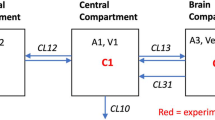Abstract
Drug disposition in the brain was investigated by statistical moment analysis using an improved in situ brain perfusion technique. The right cerebral hemisphere of the rat was perfused in situ. The drug and inulin were injected into the right internal carotid artery as a rapid bolus and the venous outflow curve at the posterior facial vein was obtained. The infusion rate was adjusted to minimize the flow of perfusion fluid into the left hemisphere. The obtained disposition parameters were characteristics and considered to reflect the physicochemical properties of each drug. Antipyrine showed a small degree of initial uptake. Therefore, its apparent distribution volume (V i) and apparent intrinsic clearance (CLint,i) were small. Diazepam showed large degrees of both influx and efflux and, thus, a large Vi. Water showed parameters intermediate between those of antipyrine and those of diazepam. Imipramine, desipramine, and propranolol showed a large CLint,i compared with those of the other drugs. The extraction ratio of propranolol significantly decreased with increasing concentrations of unlabeled propranolol in the perfusion fluid. These findings may be explained partly by the tissue binding of these drugs. In conclusion, the present method is useful for studying drug disposition in the brain.
Similar content being viewed by others
REFERENCES
S. I. Rapoport. Blood-Brain Barrier in Physiology and Medicine, Raven Press, New York, 1979.
W. M. Pardridge and W. H. Oldendorf. Transport of metabolic substrate through the blood-brain barrier. J. Neurochem. 28:5–12 (1977).
S. Mayer, R. P. Maickel, and B. B. Brodie. Kinetics of penetration of drugs and other foreign compounds into cerebrospinal fluid and brain. J. Pharmacol. Exp. Ther. 127:205–211 (1959).
B. B. Brodie, H. Kurz, and L. S. Schanker. The importance of dissociation constant and lipid-solubility in influencing the passage of drugs into the cerebrospinal fluid. J. Pharmacol. Exp. Ther. 130:20–25 (1960).
J. D. Fenstermacher, R. G. Blasberg, and C. S. Patlak. Methods for quantifying the transport of drugs across brain barrier system. Pharmacol. Ther. 14:217–248 (1981).
C. Crone. The permeability of capillaries in various organs determined by use of the indicator dilution method. Acta Physiol. Scand. 58:292–305 (1963).
C. Crone. The permeability of brain capillaries to nonelectrolytes. Acta Physiol. Scand. 64:407–417 (1965).
W. H. Oldendorf. Measurement of brain uptake of radiolabeled substances using a tritiated water internal standard. Brain Res. 24:372–376 (1970).
S. I. Rapoport, K. Ohno, and K. D. Pettigrew. Drug entry into brain. Brain Res. 172:354–359 (1979).
Y. Takasato, S. I. Rapoport, and Q. R. Smith. In situ brain perfusion technique to study cerebrovascular transport in the rat. Am. J. Physiol. 247:H484–H493 (1984).
T. Sakane, C. Tanaka, A. Yamamoto, M. Hashida, H. Sezaki, H. Ueda, and H. Takagi. The effect of polysorbate 80 on brain uptake and analgesic effect of D-kyotorphin. Int. J. Pharm. 57:77–83 (1989).
K. Yamaoka, T. Nakagawa, and T. Uno. Statistical moments in pharmacokinetics. J. Pharmacokinet. Biopharm. 6:547–558 (1978).
D. J. Cutler. Theory of the mean absorption time, an adjunct to conventional bioavailability studies. J. Pharm. Pharmacol. 30:476–478 (1978).
T. Kakutani, K. Yamaoka, M. Hashida, and H. Sezaki. A new method for assessment of drug disposition in muscle: application of statistical moment theory to local perfusion systems. J. Pharmacokinet. Biopharm. 13:609–631 (1985).
K. Nishida, C. Tonegawa, T. Kakutani, M. Hashida, and H. Sezaki. Statistical moment analysis of hepatobiliary transport of phenol red in the perfused rat liver. Pharm. Res. 6:140–146 (1989).
E. C. Greene. Anatomy of the Rat, Hafner, 1963.
M. Weiss. Theorems on long-convex disposition curves in drug and tracer kinetics. J. Theor. Biol. 116:355–368 (1985).
O. B. Paulson, M. M. Hertz, T. G. Bolwig, and N. A. Lassen. Filtration and diffusion of water across the blood-brain barrier in man. Microvasc. Res. 13:113–124 (1977).
T. W. Furlow and N. H. Bass. Cerebral hemodynamics in the rat assessed by a non-diffusible indicator dilution technique. Brain Res. 110:366–370 (1976).
S. Momma and Q. R. Smith. Validity of four assumptions of the in situ brain perfusion technique. Soc. Neurosci. Abstr. 11:840 (1985).
B. K. Siesjo. Brain Energy Metabolism, John Wiley & Sons, Chichester, 1978.
M. M. Hertz and T. G. Bolig. Blood-brain barrier studies in the rat: An indicator dilution technique with tracer sodium as an internal standard for estimation of extracerebral contamination. Brain Res. 106:333–343 (1976).
Y. Sawada, C. S. Patlak, and R. G. Blasberg. Kinetic analysis of cerebrovascular transport based on indicator dilution technique. Am. J. Physiol. 256:H794–H812 (1989).
J. Greenwood, A. S. Hazell, and P. J. Luthert. The effect of a low pH saline perfusate upon the integrity of the energy-depleted rat blood-brain barrier. J. Cerebr. Blood Flow Metab. 9:234–242 (1989).
R. Atsumi, K. Endo, T. Kakutani, Y. Takakura, M. Hashida, and H. Sezaki. Disposition characteristics of mitomycin C-dextran conjugate in normal and tumor-bearing muscles of rabbits. Cancer Res. 47:5546–5551 (1987).
R. Hori, Y. Tanigawara, Y. Saito, Y. Hayashi, T. Aiba, K. Okumura, and A. Kamiya. Moment analysis of drug disposition in kidney: Transcellular transport kinetics of p-aminohippurate in the isolated perfused rat kidney. J. Pharm. Sci. 77:471–416 (1988).
W. M. Pardridge and G. Fierer. Blood-brain barrier transport of butanol and water relative to N-isopropyl-p-iodoamphetamine as the internal reference. J. Cerebr. Blood Flow Metab. 5:275–281 (1985).
W. M. Pardridge, R. Sakiyama, and G. Fierer. Blood-brain barrier transport and brain sequestration of propranolol and lidocaine. Am. J. Physiol. 247:R582–R588 (1984).
Author information
Authors and Affiliations
Rights and permissions
About this article
Cite this article
Sakane, T., Nakatsu, M., Yamamoto, A. et al. Assessment of Drug Disposition in the Perfused Rat Brain by Statistical Moment Analysis. Pharm Res 8, 683–689 (1991). https://doi.org/10.1023/A:1015833513567
Issue Date:
DOI: https://doi.org/10.1023/A:1015833513567




